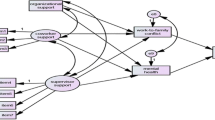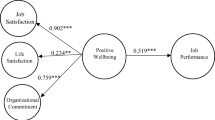Abstract
This paper uses life satisfaction regressions based on three surveys in two countries (Canada and the United States) to estimate the relative values of financial and non-financial job characteristics. The well-being results show strikingly large values for non-financial job characteristics, especially workplace trust and other measures of the quality of social capital in workplaces. For example, an increase of trust in management that is about one tenth of the scale has a value in terms of life satisfaction equivalent to an increase of more than 30% in monetary income. We find that these values differ significantly by gender and by union status. We consider the reasons for such large values, and explore their implications for employers, employees, and policy-makers.






Similar content being viewed by others
Notes
If a version of Eq. 1 is estimated using all six job characteristics and three education level variables, the sign patterns are as described in the text. Of the ‘correctly’ (negatively) signed job characteristics, “free of conflicting demands” is insignificant.
As pointed out by a referee, health status is a highly endogenous variable. Our purpose for including it is two-fold: to account separately for the importance of subjective health as a determinant of life satisfaction, and to help control for possible interpersonal differences in optimism. Excluding the health variable from the regression raises the coefficients on income and on job satisfaction slightly. But the ratio between the two is little changed. In the case of ESC full-sample estimation in column 1 of Table 1, the ratio changes from 0.93 with the health variable included to 0.94 without.
An instrument variable ideally will incorporate external information other than an individual worker’s own responses to survey questions to avoid endogeneity. In the case of Bryson et al. (2004), such external information is managers’ evaluations of industrial relations in the establishments where respondents are employed. Our surveys provide little external information.
In the fourth column of Table 2, which has the regression result for female workers, the coefficient on the standardized trust in management is 1.25 times as large as the coefficient on the log of personal income. This implies that we can multiply the difference in standardized trust by 1.25 to turn it into income-equivalent units. The gender difference in the average assessment of trust in management is 0.13, with females being higher. The difference amounts to 0.057 standardized units. The corresponding income-equivalent value is therefore 0.057 × 1.25 = 0.071. The gender difference in personal income per hour of work is 0.19, with females being lower. Therefore the difference in workplace trust contributes almost two-fifths (0.071/0.19 = 0.37) of the gender difference in hourly earnings.
There has been increasing interest in the topic within the human resources research community. For example, a 2003 special issue of the International Journal of Human Resource Management was devoted to workplace trust. See Ziffane and Connell (2003). For a survey of some of the related research in psychology, see Kramer (1999).
References
Böckerman, P., & Ilmakunnas, P. (2009). Job disamenities, job satisfaction, quit intentions, and actual separations: Putting the pieces together. Industrial Relations, 48(1), 73–96.
Bonhomme, S., & Jolivet, G. (2009). The pervasive absence of compensating differentials. Journal of Applied Econometrics, 24(5), 763–795.
Bryson, A., Cappellari, L., & Lucifora, C. (2004). Does union membership really reduce job satisfaction? British Journal of Industrial Relations, 42(3), 439–459.
Clark, A. E. (1997). Job satisfaction and gender: Why are women so happy at work? Labour Economics, 4, 341–372.
Clark, A. E. (2001). What really matters in a job? Hedonic measurement using quit data. Labour Economics, 8(2), 223–242.
Corneliben, T. (2009). The interaction of job satisfaction, job search, and job changes. An empirical investigation with German panel data. Journal of Happiness Studies, 10, 367–384.
Fortin, N. (2005). Gender role attitudes and the labour market outcomes of women across OECD countries. Oxford Review of Economic Policy, 21(3), 416–438.
Frey, B. S., & Stutzer, A. (2004). Economic consequences of mispredicting utility. Working paper 218. University of Zurich: Institute for Empirical Research in Economics.
Halpern, D. (2005). Social capital. Cambridge: Polity Press.
Helliwell, J. F., & Huang, H. (2010). How’s the job? Well-being and social capital in the workplace. Industrial and Labor Relations Review, 63(2), 205–227.
Helliwell, J. F., & Putnam, R. D. (2004). The social context of well-being. Philosophical transactions of the Royal Society of London Series B 359: 1435–1446. Reprinted in F. A. Huppert, B. Kaverne & N. Baylis (Eds.) (2005) The science of well-being (pp. 435–459). London: Oxford University Press.
Hwang, H.-S., Reed, W. R., & Hubbard, C. (1992). Compensating wage differentials and unobserved productivity. Journal of Political Economy, 100(4), 835–858.
Kramer, R. M. (1999). Trust and distrust in organizations: Emerging perspectives, enduring questions. Annual Review of Psychology, 50, 569–598.
Putnam, R. D. (2000). Bowling alone: The collapse and revival of American community. New York: Simon and Schuster.
Soroka, S., Helliwell, J. F., & Johnston, R. (2006). Measuring and modelling interpersonal trust. In Kay. Fiona & Johnston. Richard (Eds.), Diversity, social capital and the welfare state (pp. 95–132). Vancouver: UBC Press.
Van Praag, B. M. S., & Baarsma, B. E. (2005). Using happiness surveys to value intangibles: The case of aircraft noise. Economic Journal, 115, 224–246.
Villanueva, E. (2007). Compensating wage differentials and voluntary job changes: Evidence from Germany. Industrial and Labor Relations Review, 60(4), 544–561.
Ziffane, R., & Connell, J. (2003). Trust and HRM in the new millennium. International Journal of Human Resource Management, 14(1), 3–11.
Author information
Authors and Affiliations
Corresponding authors
Appendix
Rights and permissions
About this article
Cite this article
Helliwell, J.F., Huang, H. Well-Being and Trust in the Workplace. J Happiness Stud 12, 747–767 (2011). https://doi.org/10.1007/s10902-010-9225-7
Published:
Issue Date:
DOI: https://doi.org/10.1007/s10902-010-9225-7




